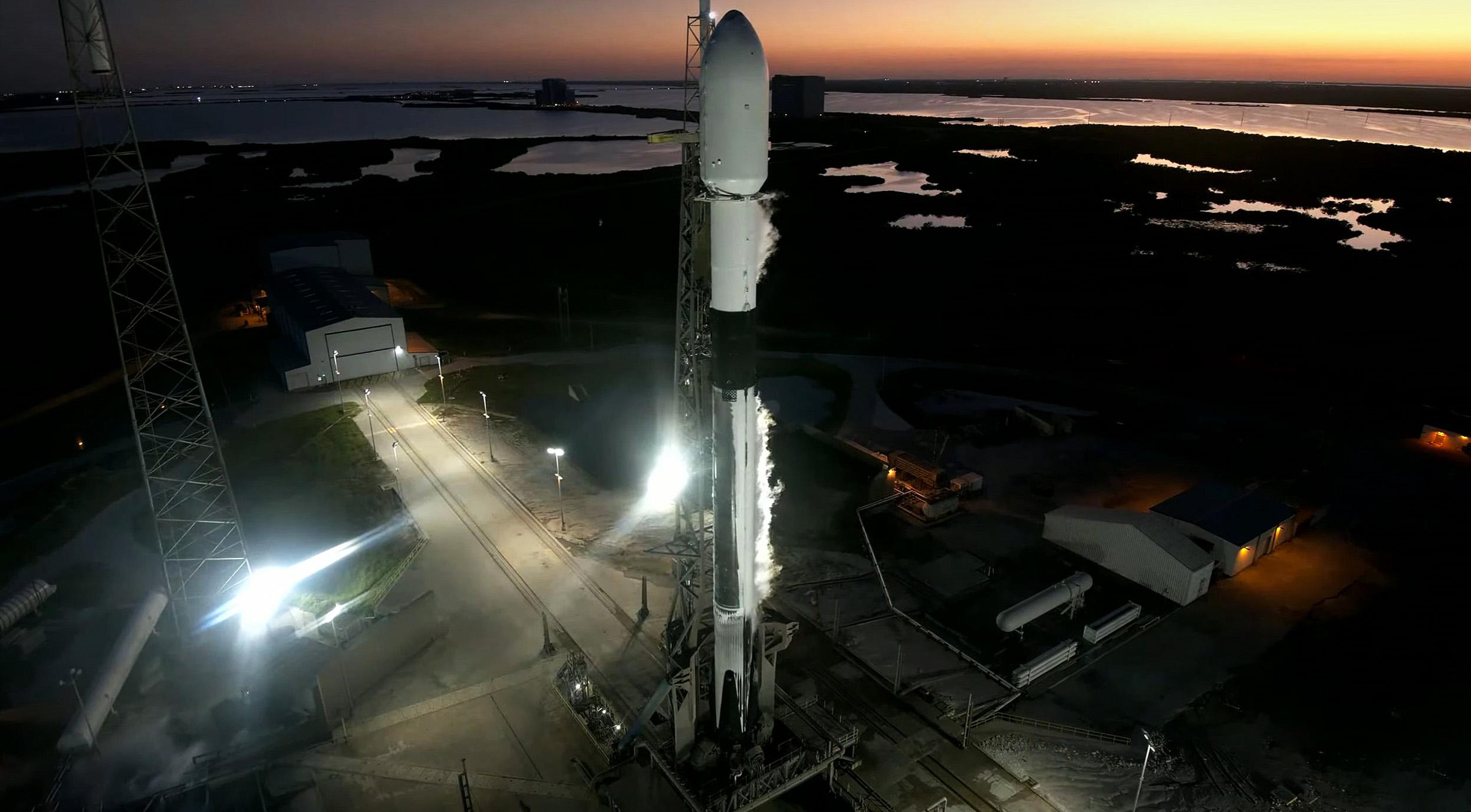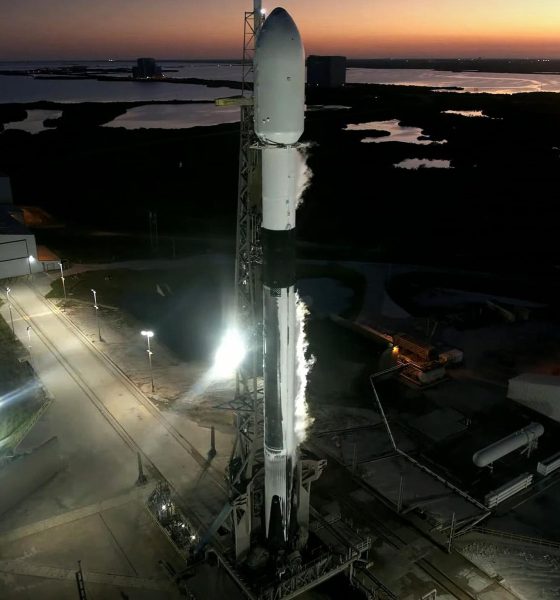

News
SpaceX’s third Falcon 9 launch in 31 hours aborted by “tiny helium leak”
SpaceX’s third Falcon 9 launch in a little over 31 hours was called off seconds before liftoff after the rocket’s onboard computer detected what Elon Musk says was a “tiny helium leak.”
SpaceX takes “no risks with customer satellites,” per the CEO, so the company has stood down from its October 6th launch attempt to inspect the rocket, analyze data gathered from tonight’s attempt, and ensure everything is in order. Barring surprises, SpaceX will attempt to launch Intelsat’s Galaxy-33 and Galaxy-34 geostationary communications satellites at the next earliest opportunity, a 69-minute window that opens at 7:06 pm EDT (23:06 UTC) on Friday, October 7th.
The abort ends an opportunity SpaceX had to launch three Falcon rockets faster than ever before, but the company was still able to crush a different (internal) record with two Falcon 9 launches in seven hours on October 5th. Thanks to its relentless pursuit of ever-higher launch cadences, SpaceX will likely have many opportunities to break its record of three launches in ~36 hours over the next several months.
Intelsat’s Galaxy-33/Galaxy-34 (G33/G34) mission would have been SpaceX’s third Falcon 9 launch in 31 hours and 20 minutes following the successful October 5th launches of Crew-5 (carrying four astronauts) at 12:00 pm EDT and Starlink 4-29 (deploying 52 Starlink satellites) at 7:10 pm EDT. The hat-trick record for a non-SpaceX vehicle appears to have been previously held by the Soviet R-7 rocket family, which completed three launches in 40 hours in March 1978.
SpaceX broke that record in June 2022 when it launched Starlink 4-19, SARah-1, and Globalstar FM15 a little over 36 hours apart. It will now have to wait for another opportunity to break its own record, though it likely won’t be too long as the company continues to target 60 launches in 2022 and “up to” 100 launches in 2023.

According to a SpaceX launch controller, Falcon 9’s first ill-fated Galaxy-33/Galaxy-34 launch attempt was aborted automatically when the rocket’s flight computer “identified higher than expected cryo helium decay.” SpaceX’s Falcon rockets burn a combination of cryogenic liquid oxygen and chilled rocket-grade kerosene (RP-1), but they carry composite overwrapped pressure vessels (COPVs) filled with high-pressure helium gas to keep their propellant tanks pressurized as they’re drained. If SpaceX’s much larger Starship rocket shares some similarities, the company may also use a system of “helium injection” [PDF] inside Falcon 9 to keep its cryogenic oxygen and chilled kerosene as cold as possible. Musk later simplified the cause of the abort to a “tiny helium leak,” but the location of the leak (inside or outside of the rocket) was not specified.
Two hours before that, the Crew Dragon spacecraft SpaceX launched the day prior successfully docked with the International Space Station (ISS), delivering its ‘payload’ of four professional astronauts to the orbital outpost. One of those passengers is Russian cosmonaut Anna Kikina, marking the first time an American spacecraft has ferried a Russian to the ISS in almost 20 years. That milestone has unfortunately been muddied and overshadowed by the country’s illegal, genocidal, and increasingly suicidal invasion of Ukraine.
Crew-5 is the seventh Crew Dragon to successfully transport astronauts to the ISS and SpaceX’s eighth crewed launch overall since May 2020. Flying for the second time, Crew Dragon capsule C210 docked on its first try after a smooth 29-hour rendezvous. About a week from now, another crew of four astronauts will board a different Crew Dragon spacecraft and return to Earth, handing off the ISS to Crew-5 and ending SpaceX and NASA’s Crew-4 mission.
SpaceX is scheduled to launch at least one more batch of astronauts for NASA in March or April 2023, meaning that the company is expected to singlehandedly ensure NASA access to the ISS for almost three full years. At the start of the Commercial Crew Program and for most of its development, NASA intended for partners SpaceX and Boeing to alternate, but Boeing’s Starliner spacecraft is years behind schedule.

Elon Musk
Elon Musk’s X will start using a Tesla-like software update strategy
The initiative seems designed to accelerate updates to the social media platform, while maintaining maximum transparency.

Elon Musk’s social media platform X will adopt a Tesla-esque approach to software updates for its algorithm.
The initiative seems designed to accelerate updates to the social media platform, while maintaining maximum transparency.
X’s updates to its updates
As per Musk in a post on X, the social media company will be making a new algorithm to determine what organic and advertising posts are recommended to users. These updates would then be repeated every four weeks.
“We will make the new 𝕏 algorithm, including all code used to determine what organic and advertising posts are recommended to users, open source in 7 days. This will be repeated every 4 weeks, with comprehensive developer notes, to help you understand what changed,” Musk wrote in his post.
The initiative somewhat mirrors Tesla’s over-the-air update model, where vehicle software is regularly refined and pushed to users with detailed release notes. This should allow users to better understand the details of X’s every update and foster a healthy feedback loop for the social media platform.
xAI and X
X, formerly Twitter, has been acquired by Elon Musk’s artificial intelligence startup, xAI last year. Since then, xAI has seen a rapid rise in valuation. Following the company’s the company’s upsized $20 billion Series E funding round, estimates now suggest that xAI is worth tens about $230 to $235 billion. That’s several times larger than Tesla when Elon Musk received his controversial 2018 CEO Performance Award.
As per xAI, the Series E funding round attracted a diverse group of investors, including Valor Equity Partners, Stepstone Group, Fidelity Management & Research Company, Qatar Investment Authority, MGX, and Baron Capital Group, among others. Strategic partners NVIDIA and Cisco Investments also continued support for building the world’s largest GPU clusters.
News
Tesla FSD Supervised wins MotorTrend’s Best Driver Assistance Award
The decision marks a notable reversal for the publication from prior years, with judges citing major real-world improvements that pushed Tesla’s latest FSD software ahead of every competing ADAS system.

Tesla’s Full Self-Driving (Supervised) system has been named the best driver-assistance technology on the market, earning top honors at the 2026 MotorTrend Best Tech Awards.
The decision marks a notable reversal for the publication from prior years, with judges citing major real-world improvements that pushed Tesla’s latest FSD software ahead of every competing ADAS system. And it wasn’t even close.
MotorTrend reverses course
MotorTrend awarded Tesla FSD (Supervised) its 2026 Best Tech Driver Assistance title after extensive testing of the latest v14 software. The publication acknowledged that it had previously criticized earlier versions of FSD for erratic behavior and near-miss incidents, ultimately favoring rivals such as GM’s Super Cruise in earlier evaluations.
According to MotorTrend, the newest iteration of FSD resolved many of those shortcomings. Testers said v14 showed far smoother behavior in complex urban scenarios, including unprotected left turns, traffic circles, emergency vehicles, and dense city streets. While the system still requires constant driver supervision, judges concluded that no other advanced driver-assistance system currently matches its breadth of capability.
Unlike rival systems that rely on combinations of cameras, radar, lidar, and mapped highways, Tesla’s FSD operates using a camera-only approach and is capable of driving on city streets, rural roads, and freeways. MotorTrend stated that pure utility, the ability to handle nearly all road types, ultimately separated FSD from competitors like Ford BlueCruise, GM Super Cruise, and BMW’s Highway Assistant.
High cost and high capability
MotorTrend also addressed FSD’s pricing, which remains significantly higher than rival systems. Tesla currently charges $8,000 for a one-time purchase or $99 per month for a subscription, compared with far lower upfront and subscription costs from other automakers. The publication noted that the premium is justified given FSD’s unmatched scope and continuous software evolution.
Safety remained a central focus of the evaluation. While testers reported collision-free operation over thousands of miles, they noted ongoing concerns around FSD’s configurable driving modes, including options that allow aggressive driving and speeds beyond posted limits. MotorTrend emphasized that, like all Level 2 systems, FSD still depends on a fully attentive human driver at all times.
Despite those caveats, the publication concluded that Tesla’s rapid software progress fundamentally reshaped the competitive landscape. For drivers seeking the most capable hands-on driver-assistance system available today, MotorTrend concluded Tesla FSD (Supervised) now stands alone at the top.
News
Elon Musk’s Grokipedia surges to 5.6M articles, almost 79% of English Wikipedia
The explosive growth marks a major milestone for the AI-powered online encyclopedia, which was launched by Elon Musk’s xAI just months ago.

Elon Musk’s Grokipedia has grown to an impressive 5,615,201 articles as of today, closing in on 79% of the English Wikipedia’s current total of 7,119,376 articles.
The explosive growth marks a major milestone for the AI-powered online encyclopedia, which was launched by Elon Musk’s xAI just months ago. Needless to say, it would only be a matter of time before Grokipedia exceeds English Wikipedia in sheer volume.
Grokipedia’s rapid growth
xAI’s vision for Grokipedia emphasizes neutrality, while Grok’s reasoning capabilities allow for fast drafting and fact-checking. When Elon Musk announced the initiative in late September 2025, he noted that Grokipedia would be an improvement to Wikipedia because it would be designed to avoid bias.
At the time, Musk noted that Grokipedia “is a necessary step towards the xAI goal of understanding the Universe.”
Grokipedia was launched in late October, and while xAI was careful to list it only as Version 0.1 at the time, the online encyclopedia immediately earned praise. Wikipedia co-founder Larry Sanger highlighted the project’s innovative approach, noting how it leverages AI to fill knowledge gaps and enable rapid updates. Netizens also observed how Grokipedia tends to present articles in a more objective manner compared to Wikipedia, which is edited by humans.
Elon Musk’s ambitious plans
With 5,615,201 total articles, Grokipedia has now grown to almost 79% of English Wikipedia’s article base. This is incredibly quick, though Grokipedia remains text-only for now. xAI, for its part, has now updated the online encyclopedia’s iteration to v0.2.
Elon Musk has shared bold ideas for Grokipedia, including sending a record of the entire knowledge base to space as part of xAI’s mission to preserve and expand human understanding. At some point, Musk stated that Grokipedia will be renamed to Encyclopedia Galactica, and it will be sent to the cosmos.
“When Grokipedia is good enough (long way to go), we will change the name to Encyclopedia Galactica. It will be an open source distillation of all knowledge, including audio, images and video. Join xAI to help build the sci-fi version of the Library of Alexandria!” Musk wrote, adding in a later post that “Copies will be etched in stone and sent to the Moon, Mars and beyond. This time, it will not be lost.”








